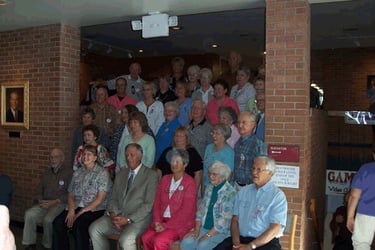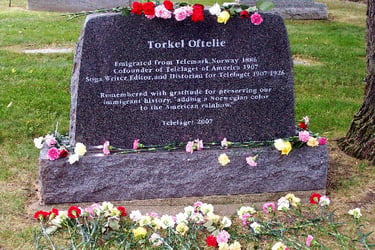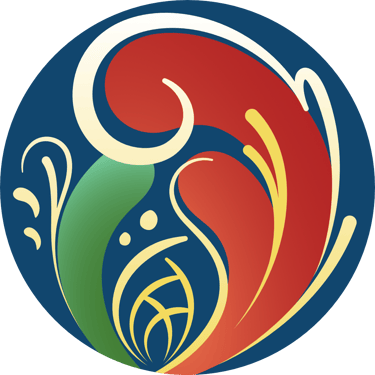Let's Rally in the Valley
July 12-14 2007
Gene Estensen
11/23/20077 min read


Wahpeton, North Dakota
Telelaget's 100th Anniversary
The theme was "Let's Rally in the Valley." and members of the 7 Lags rallied at Wahpeton State School of Science. Telelaget was founded in 1907, and celebrated the 100th anniversary of that event at a special Friday evening banquet. Over 80 people attended the 100th Anniversary banquet. A large cake was shared by all. Alice Kirn did a masterful job setting up the display area. John Haugo led the way as master of ceremonies. Marilyn Sorenson, president of the Bygdelagenes Fellesraad, presented Elaine Nordlie, Telelaget's president, with a beautiful gift marking the historic anniversary. The Oftelie family was present as the theme of the banquet was honoring our founders. Gene Estensen gave a short speech honoring Torkel for his contributions to Telelaget. Pictures of those present at the banquet were taken immediately after the banquet. Lag members made the short trip to Fergus Falls, Minnesota, to dedicate a memorial to Torkel Oftelie at his gravesite.
Honoring Torkel Oftelie of Fergus Falls, Minnesota
Delivered at Telelaget's 100th Anniversary Banquet
Wahpeton, North Dakota
July 13, 2007, By Gene Estensen
Earlier this month, on the 4th of July, I was reading a piece in the St. Petersburg Times. It was written by Roger Simon and was titled "From the Ordinary, Greatness". One paragraph caught my attention:
"Years and years of history books have taught us that America was shaped by the great deeds of great men and women. It was not. America was shaped by the great deeds of ordinary men and women."
It could be said that America was shaped by ordinary people doing extraordinary things. This year we are honoring an ordinary man who did extraordinary things, Torkel Oftelie of Fergus Falls, Minnesota.
Those of us with ancestors from Telemark are fortunate indeed that a certain Torkel Oftelie devoted his adult life to documenting the stories of ordinary folk that came to America from Telemark. He was known for the saying, "Remember the Telers". Torkel Oftelie brought them to life through his writings. We know where they lived because Torkel visited the various settlements across the Midwest. We know of their clothing, their music, and their politics. Of great importance, we are reminded of their hardships. Rasmus Anderson wrote in his book on Norwegian immigration (Norwegian Immigration 1821-1840, p. 432):
"How our fathers toiled and how much they suffered, we, their descendants, who are now enjoying the fruits of their labors, can never realize or know; and we owe them a debt of gratitude which we can never pay. The best we can do is to live worthy lives and to try to keep green the memories of those who did so little for themselves and so much for us."
Through his writing, Torkel Oftelie kept green the memories.
Looking back, we can see that Torkel found his destiny during the winter of 1906-07, exactly one hundred years ago. He would write of it in 1926 with these words:
"Just before Christmas in 1906 a cry was sent out for some Telers to start a Telelag. Those who signed up during this call were Pastor B. Bondal, Torkel Oftelie, A. A. Trovatten, Kjetil Knutson, Gunder Howard and Torjus Lundevall. We held a meeting in a hall in Fargo, January 16, 1907.
Years later, Torkel wrote that "the movement, which began like a rustling in the corn on a summer's day, turned into a 20-year commitment." Here we see the power of Torkel's words. Is there anyone here that is not familiar with the rustling of the corn?
During those winter meetings of 1906-07 Torkel was elected to a five-year term as soga-writer, story writer. He set about his work with a passion. From 1907 until 1924 he wrote 53 issues of TeleSoga. Then he stopped writing TeleSoga. It was not until 1950 that another TeleSoga was printed. In our 100-year history, half of all issues of TeleSoga were written by Torkel Oftelie.
He wrote the TeleSoga at his own expense. I repeat, he wrote the TeleSoga at his own expense. Think of the impact on his wife Signe.
I wonder what she thought when he announced that he would spend the winter of 1911 at Lake Mills and Joice in Iowa to write up the stories of the Telers in Worth and Winnebago Counties.
The next year, 1912, it was the months of February and March in the settlements of Trempealeau Valley, Wisconsin. In the summer of that year, he was in Chippewa and Yellow Medicine Counties.
I wonder what Signe thought when he announced that he would spend February and March of 1913 in Fillmore and Houston Counties, to write up the Telers in the oldest settlements in Minnesota. He went down to Decorah, Iowa and to the nearby Ridgeway Settlement too. That same March he would write up the Telers in Santiago and Glendorado, Minnesota at the request of Pastor Langseth. He took a trip there to become acquainted both with the Telers and with the pastor.
In the fall of 1920, he made a trip all the way to Nebraska and wrote about the Telers there.
In 1922 it was a trip to Indianland in eastern Wisconsin.
What did Signe think about all of this travel? Thank you, Signe, for letting Torkel find his destiny.
The goal of Torkel's travel was to sell memberships to Telelaget and to raise the necessary money to fund the publishing of TeleSoga. So how did he travel? Torkel left us with these thoughts:
"When one drives a car, no-one takes any notice, and he can't see much of the land, either. No-one knows what Minnesota is, before having driven through with a horse. For me it was an adventure, fine roads, and fine weather, and kind people."
Yes, Torkel made his journeys by train, by horse-and-buggy, and on foot. He was a humorous and outgoing man. He could always find the home of a Teler to spend the night. We can only imagine the delightful conversations, the music, and the poetry, that ran late into the night. And thus, the tale of the Telers was recorded and told, and re-told, one Teler home at a time throughout the Midwest.
Here is some more insight into Torkel Oftelie, the man. His good friend was Herbjørn Gausta, the famous painter from Tinn, Telemark and a resident of Harmony, Minnesota. When Herbjørn died, Torkel led the great fund raiser to place a monument to Gausta at the old settler's cemetery of Greenfield Lutheran Church at Harmony. I have seen this monument at Harmony because near it rests my g-g-g-grandfather Osten, born 1790 in Tinn, Telemark. Here are Torkel's words regarding the fundraising:
"If the project were to succeed, I knew I would have to go there and begin collecting among the people of his own district, and get it started. After a discussion with Pastor Sæther, I went down there early in March, 1925. Sæther went with me to Minneapolis. It went fairly well. I got 1.00 or 2.00 and up to 5.00 from some. I promised them that we would hold a Telelag at Harmony, when we unveiled the monument, and that helped. I got Banker Tollef Sanderson, and Tinndaler Hans Barnum, to see about getting a Bauta-stone, when we had collected enough money." End quote. We of Telelaget are so, so late in adding a monument to the grave of Torkel Oftelie, but this year it will be done."
By 1926 Torkel could no longer manage the increased costs publishing Telesoga. He stopped writing TeleSoga. However, Torkel left us with his "Yearbook of 1926". In it he wrote:
"The idea of the writings, first and foremost, is to tell us how Telers have succeeded in America."
At that mission, Torkel succeeded to the benefit of Telers for generations to come.
Torkel was nearly 80 years of age when he returned to Norway for a visit. It lasted three months. Torkel received a hero's welcome. The people in his home district held three large public meetings in his honor. We can only imagine how pleased our soga-writer, author, teacher, singer, and historian must have been. Certainly, he was in his glory.
As I near my close, I would like to point out that there is a new "rustling in the corn on a summer's day." Some of us are wondering if just maybe we should return to the places that Torkel visited, exactly 100 years later. After all, there should be Teler descendants on the farms that Torkel visited in the early years of Telelaget.
I will close with the words of Eugene Leach, Historian for Racine County, Wisconsin. Think of Torkel as I read this. Eugene Leach wrote:
"To a chosen few historically minded persons in each generation are given the privilege of collecting and preserving the sacred facts of history, that they may not be lost to future generations.”.
Thank you for listening! "Remember the Telers".
"For the love of a girl"
Delivered at the Cemetery Dedication
Fergus Falls, Minnesota
July 14, 2007, By Gene Estensen
For the love of a girl Torkel Oftelie came from the mountains of Telemark to the great plains of America. That girl was Signe Groven Oftelie and she rests here next to Torkel. To Signe we express our deepest gratitude for letting Torkel find his destiny. Torkel was one of the founders of our organization, Telelaget of America, 100 years ago. Torkel was elected Soga-writer, story-writer, and took to the job with a passion. For twenty years Torkel was away from home a great deal of the time, recording the history of the pioneers in America that came from the Telemark region of Norway. He traveled about the Midwest, mostly by horse-and-buggy and at his own expense, visiting the "Telers" and recording their stories. He wrote the first 53 issues of our journal, TeleSoga.
At the very first Telelag Stevne (meeting) in June of 1907 Torkel spoke passionately that his main purpose was:
o "To write about the immigrant's history in this country"
o "We have a call, a big assignment that we must fulfill".
o "We need to leave an impression."
o This nation is composed of many different people, like the rainbow with its distinct colors. Let there be a Norwegian color in the American rainbow".
o "We need to see that the Telers are not forgotten."
Torkel, you certainly fulfilled the big assignment and you certainly left an impression. Your contributions to our organization are unmatched. It is our pleasure, and an honor, for those of us "Telers" here today to dedicate the inscription that is on the back of your tombstone. You are remembered with gratitude for preserving our immigrant history.
Stone placed by Telelaget














